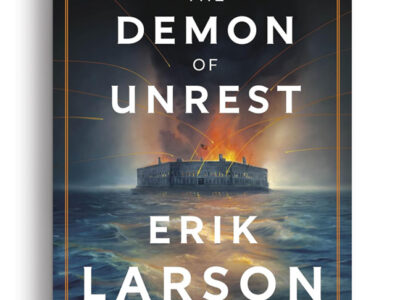When creation and destruction intersect.

THUNDERSTRUCK
By Erik Larson C’76.
Crown, 2006. $25.95.
By Julia M. Klein | The premonitory title of Erik Larson’s 2003 bestseller, The Devil in the White City, underlined what Larson called “the ineluctable contrast between good and evil, daylight and darkness, the White City and the Black.” A National Book Award finalist and Edgar Award winner, Devil told distinct, but peripherally intersecting, stories about two men with very different skill sets: the serial killer H.H. Holmes and the architect Daniel Burnham, who presided over the building of the famed White City for the 1893 Chicago World’s Fair.
Good news for his many fans: Larson’s newest nonfiction narrative and fifth book, Thunderstruck, is structurally similar and comparably involving, enticing readers once again into a well-delineated turn-of-the-century world. But it’s also less Manichaean in its moral perspective, and in that sense perhaps an even more provocative read.
Like Devil, Thunderstruck shuttles back and forth between two different narratives involving the polar extremes of creation and destruction. One story concerns the precocious Italian electrical engineer, Guglielmo Marconi, who blunders his way to the invention of the wireless, or radio, while alienating those closest to him. It’s a tale ultimately of triumph, though at a cost, including an abortive engagement and a failed marriage.
Larson’s other—and considerably more gripping—story is a tragedy of both character and circumstance, a classic romantic triangle. Its tormented central figure is the patent-medicine salesman Hawley Harvey Crippen, an expatriate American living in and around London. In love with his secretary, he struggles to break free of an increasingly barren marriage within the sexually corseted confines of Edwardian England.
Though it, too, deals with murder, it’s not surprising that Thunderstruck seems to portray a more nuanced moral universe than The Devil in the White City. To Larson—and to most of us—a crime of passion, however grisly, inspires greater sympathy than the cool con artistry of a sociopathic serial killer. Crippen—tyrannized for years by his wife, Belle, a perennially aspiring music-hall performer—is something other than a pure villain. Nor is Belle simply a shrew; she attracts other admirers and is beloved by her many friends.
At the same time, Marconi, for all his gifts, is hardly an unvarnished hero. More than once, Larson, departing from the usual austerity of his prose to convey something like disgust, accuses the future Nobel laureate of “social blindness” in his treatment of rivals, employees, and intimates alike.
As a writer, Larson has two great, and complementary, gifts. He is, as The Chicago Sun-Times has felicitously proclaimed, “a historian … with a novelist’s soul.” Trained as a journalist and blessed with a passion for archival research, Larson is able to paint an extraordinarily detailed picture of his characters’ lives, taking us inside Belle and Crippen’s dusty, disheveled home and into the bowels of its basement, where its secrets lie. He also provides a close-up of the infighting and distractions that marked the invention of the wireless, including the supernatural obsessions of the renowned physicist Oliver Lodge.
The intimacy of Larson’s narrative imbues Thunderstruck with novelistic conviction. True, this is the sort of “novel” that eschews the experiments of modernism; Larson steers clear of psychological guesswork, if not irony. He stresses, as he did in Devil, that every quotation derives from an actual document, and that nothing is invented. Still, it’s often possible to forget that one is reading nonfiction.
The title of Thunderstruck has both literal and metaphorical resonance. As Marconi embarks on a quest to create transatlantic wireless communication that will supercede the telegraph, his stations are repeatedly plagued, and often destroyed, by thunderstorms. The title also alludes to the book’s astonishing climax: the encounter between the fleeing Crippen and his pursuers.
This is not much of a spoiler. The main outlines of Larson’s twinned tales are clear from the outset: We know from elementary school that Marconi will invent the radio, and from Larson that Crippen will commit “the second most famous” murder in English history. Early on, Larson sets the scene for the transatlantic chase that is the book’s pivot and frame, warning us that a certain sea captain is about to step “into the intersection of two wildly disparate stories, whose collision on his ship in this time … would exert influence on the world for the century to come.”
In a way, Larson resembles a magician who reveals what’s up his sleeve, but still manages to wow us. It’s a credit to his literary legerdemain that he can blithely telegraph (forgive the expression) his story’s ending and still leave us a tad thunderstruck as his two narratives slide into one.
Julia M. Klein is a cultural reporter and critic in Philadelphia who writes for Mother Jones, The New York Times, The Wall Street Journal, and other publications.




